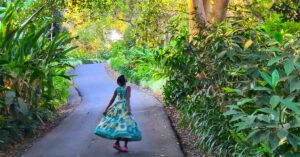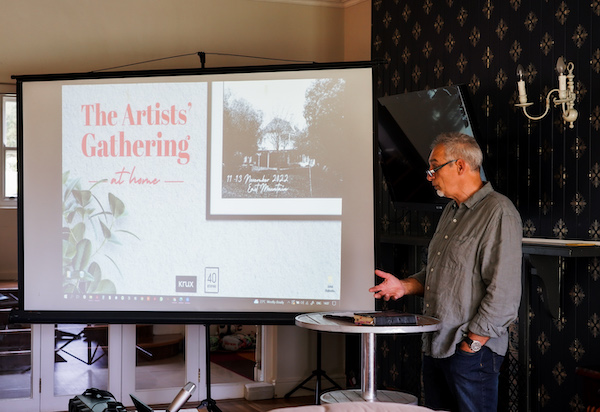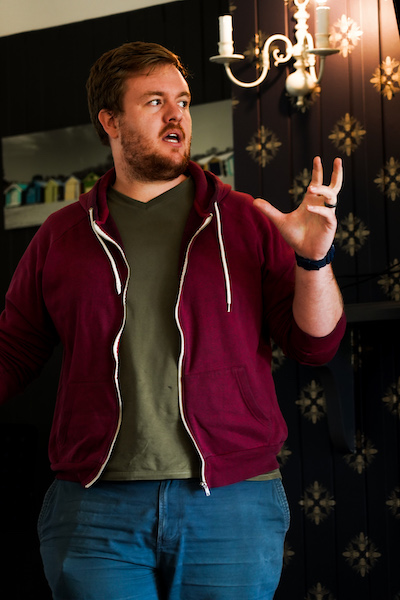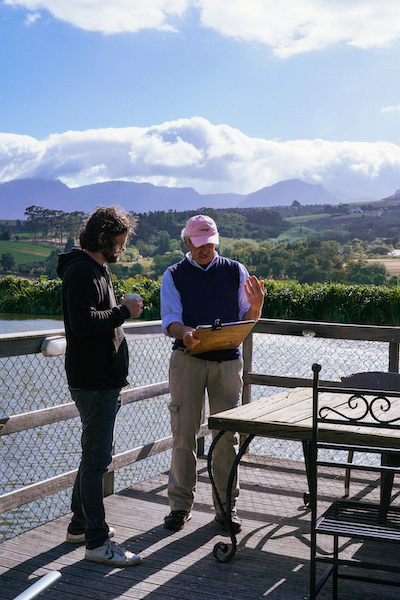

Heidi Salzwedel, a graduate of Stellenbosch and Rhodes Universities, is an art and design educator, and an artist/ writer who lives and works in Cape Town. She is a member of KRUX and one of the founders of the annual Artists’ Gathering conference. For more about KRUX visit www.krux.africa and learn about the history of the Artists’ Gathering here. Unless otherwise indicated, photographs are by courtesy of Christan Barnard, a member of the KRUX community.

This article explores the most recent annual KRUX Artists’ Gathering and includes stories about how artists can experience a sense of place and home through sharing in communities of generative orthodoxy.
“The Artists’ Gathering: At Home” took place in late 2022 in the green and leafy winelands of the Cape, South Africa. The much-loved annual weekend conference is a time of teaching, networking and inspiration between artists of Christian faith. The Artists’ Gathering 2022 was held at East Mountain Retreat Centre, Stellenbosch, with the lounge and communal areas of the venue providing a sense of “home” which formed an apt backdrop for the theme for the gathering. The thematic synopsis for the weekend, as laid out by the team which curated the event, was that “as artists of Christian faith, we often occupy the margins of society, the church, and the art world. The margins are a necessary and fruitful space for creative practice but can leave us asking where we truly belong.” A question undergirded the event: Is there a place where we can experience being centred and truly at home? The organising team further explained that “a home is the local place of belonging and sanctuary from which we move outwards and engage with the world around us. It’s where we can be most truly ourselves, and give full expression to the different sides of ourselves.” It is true that home is also where we experience being known by God and those around us.
On the first day of the Artists’ Gathering, attendees were welcomed with a keynote address, titled “A Theology of Home,” by Dr James Krohn, director of KRUX. He laid out a theological foundation for the weekend and cast his vision for a sense of redemptive placemaking as the calling of artists in their current global culture of displacement. He theoretically encapsulated God’s plan of emplacement, displacement and re-emplacement. God’s initial emplacement of the created in their earthly “home” as laid out in Genesis 2, is followed by the growing sense of perpetual displacement and rootlessness since the fall (Gen 3). With God as the architect, and Jesus as both the builder and the cornerstone, the call to be re-emplaced begins to play itself out as we progress through Scripture from the Old Testament into the New Testament. Krohn left attendees with food for thought as to how they were called to make redemptive art, not necessarily Christian art.

Professor Jorella Andrews of Goldsmiths, University of London, joined us virtually in the lounge via Zoom and shared with us about “Building Sites: On God’s call to return, and the book of Zechariah as a manual for contemporary artists.” She reintroduced images and words from the book of Zechariah and explained that it is a book which calls God’s people home after years of being in exile. She cast light on the words insisting that the homecoming must centre on rebuilding God’s house before focusing on rebuilding our own. Andrews believes that this book can also be approached as a manual bringing hopeful insight and courage to artists working in times of placelessness and spiritual devastation.
Jarrod Howard-Browne, the design editor of The Big Picture magazine and film enthusiast, presented on “Transcendental Style” and facilitated a film viewing and discussion. Howard-Browne opened our eyes to a slower mode of viewing. The film we watched in community, First Reformed, fostered a sense of leaning away so that the viewer can lean in. Transcendental style withholds from the viewer the usual action present in most films, so that the viewer has to slow down and rest, even to the point of boredom. It is a style which makes space for the transcendent to be seen by means of withholding information and that which one would ordinarily expect. Howard-Browne invited viewers into a slower sense of place and home, by introducing artists to a film that forces liminal spaces of in-betweenness and non-action.


Dr Stella Viljoen, an associate professor in visual studies at Stellenbosch University, asked many questions in her talk titled “Is the male gaze still a thing? A feminist game of dress-up and what we can learn from it.” Viljoen revealed the art of two enormously successful photographers who each embody a specific era of feminist politics, Cindy Sherman from the seventies in America, and Zanele Muholi in contemporary South Africa. She opened our eyes to how, in her words, both artists “court and critique the camera.” Viljoen asks: “Do they really subvert the ‘feminine ideal’ or merely play-act at feminism?” Viljoen opened the discussion on the notion of desire and intimacy and how the camera both brings about a close-up intimacy through portraiture, yet also violates healthy God-given intimacy through the pervasiveness of social media selfies and pornography which makes its way into our homes via the compelling pull of screens.
Throughout the weekend there were presentations, and times of shared meals and networking together. Attendees were able to learn from one another, share their experiences and ideas and form connections that usually last long after the gathering is over. The aim of the gathering as hoped for by the organising team of 2022 was to explore how, as artists, we can integrate our spiritual and creative practices, nurture meaningful relationships and contribute to the life of our local communities within a global world. By doing so we can discover how our calling to create from the margins gives us a significant role in our world today.
On the final day of the Artists’ Gathering, attendees came together around a table for a closing ceremony of sharing the Lord’s Supper, facilitated by James Krohn. The group reflected on what we had learned and experienced over the course of the weekend. We left the gathering feeling nourished with both spiritual and physical food, encouraged, and ready to continue on a path of redemptive placemaking.


